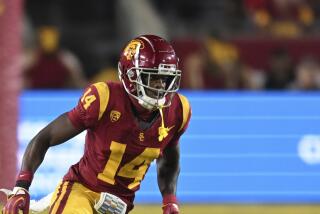FOOTBALL
- Share via
SALT LAKE CITY — Just because the 40-yard dash has been around forever doesn’t mean it’s antiquated.
A great time in the 40 still matters, at least enough to get a prospect a look he may not have received if he was just a tenth of a second slower.
“You can always teach them to catch better, but it’s hard to teach them to run faster,” said Gil Brandt, the NFL draft consultant and longtime personnel director of the Dallas Cowboys.
As intricate as evaluating NFL potential has become, the 40 is one of simplest tests there is in football: run 40 yards, we’ll time you. GO!
For players who run it fast enough, it’s a possible opening to something more. Former Utah defensive back Brice McCain was considered too small and an unlikely pick before scouts came to town last month to look at him and a few other former Utes.
McCain ran the 40 twice and both times were among the fastest in the country. The scouts looked at their stopwatches and collectively timed him at 4.30 and 4.34 seconds. Suddenly, his size (5-feet-9) was much less of a concern.
“A lot of teams are very interested now,” McCain said.
Brandt said McCain could go maybe as high as the fifth round next weekend because he was able to back up his 40 speed with great marks in the shuttle run and other drills that assess quickness more than overall speed.
The 40 is only one part of the complicated formula teams use to evaluate talent. It is more relevant for receivers and defensive backs than linemen, who are evaluated more in drills that demonstrate quick feet and agility.
Paul Brown was credited with first timing the 40 when he was coaching at Ohio State in the 1940s and trying to figure out who could get downfield the fastest to cover punts. It has grown into a football staple, recognized by every player who has had to run it and hold his breath while waiting to hear the time, and by fans in need of an off-season debate topic. Teams exhaustively break down every aspect of a player -- physical and mental -- before deciding who they want on future rosters.
The one test that seems to have caught on most in the public is the 40, a much more lively topic than anticipating who will move up in the draft by nailing the team interview.
As much as the times are talked about, they’re tricky to gauge.
Each scout keeps his own, and although the distance is the same, conditions vary from site to site. A player running on grass won’t be as fast as someone on a harder, artificial surface. And nobody is clocked running in the cumbersome pads they wear when actually playing the game and not just trying out for it.
The importance of a distance few players ever have to run during a game is also debated. Prospects can survive a slow 40 time and still be drafted if that’s their only apparent flaw.
Brandt said Jerry Rice ran around a 4.65, which was obviously not a much of an indication of what kind of receiver he would be in the NFL.
Although scouts emphasize there is so much more to evaluations than just the 40, some players feel the 4-plus seconds can decide their future. Many at the annual scouting combine decline to work out there, preferring to run their own on-campus showcase.
McCain was among the other players whose future depended on “pro day,” when scouts make a scheduled stop on campus during the never-ending search for potential draftees. McCain impressed, largely with his two times in the 40, and has been getting calls from teams who weren’t so interested before.
“With my 40 time, I’ve just gotten more looks,” McCain said.
Sometimes that’s all it takes.
“A guy runs a fast 40, that’s going to open eyes,” said Zach Miller, another player who may have run himself into the late rounds of the draft last month when scouts stopped by to see him at the University of Nebraska-Omaha.
A lifelong quarterback who ran the option in college, Miller is trying extend his football career as a tight end and is about as raw as a prospect can be. His 40 time of 4.51 seconds was impressive enough that somebody may take a chance on him with a late pick.
“It doesn’t gauge how good of a football player you are, but getting into that process I think it plays a very important role,” Miller said. “That’s kind of the big thing -- how fast did you run your 40? It shows your speed, your explosiveness.”
Miller’s fast 40 will be meaningless if he can’t catch or block, skills he’s been trying to learn over the last few months.
He and McCain both enrolled at TEST Sports Football Academy in New Jersey, where they spent weeks trying to perfect their technique before the workouts that would decide their draft future.
It’s become a popular business. Players who think they can cut their 40 time and prepare for the other predraft drills will hire a professional trainer. Hey, slight improvement could be the difference between getting drafted and an invitation to training camp as an undrafted free agent.
TEST founder Brian Martin said McCain was able to knock off almost a second from his 40 time with a few adjustments in his stride. Miller was already fast enough to run the option, but also found a few ways to get his time down to the 4.5 range.
“They’re kind of under the radar,” Martin said. “Hopefully with the great results they get on the radar.”
More to Read
Go beyond the scoreboard
Get the latest on L.A.'s teams in the daily Sports Report newsletter.
You may occasionally receive promotional content from the Los Angeles Times.










